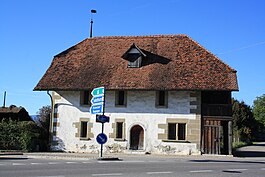Koppigen
| Koppigen | ||
|---|---|---|

Former Gasthof Bären in St Niklaus hamlet
|
||
|
||
| Coordinates: 47°8′N 7°36′E / 47.133°N 7.600°ECoordinates: 47°8′N 7°36′E / 47.133°N 7.600°E | ||
| Country | Switzerland | |
| Canton | Bern | |
| District | Emmental | |
| Area | ||
| • Total | 6.93 km2 (2.68 sq mi) | |
| Elevation | 476 m (1,562 ft) | |
| Population (Dec 2015) | ||
| • Total | 2,126 | |
| • Density | 310/km2 (790/sq mi) | |
| Postal code | 3425 | |
| SFOS number | 0413 | |
| Surrounded by | Alchenstorf, Höchstetten, Niederösch, Obergerlafingen (SO), Recherswil (SO), Utzenstorf, Willadingen, Zielebach | |
| Website |
www SFSO statistics |
|
Koppigen is a municipality in the administrative district of Emmental in the canton of Bern in Switzerland.
Koppigen is first mentioned in 1139 and again around 1181-82 as Chopingen. In 1887 the village of Brechershäusern separated from Koppigen to become part of Wynigen.
The municipal area was settled quite early in history. Neolithic items have been found at Öschberg and along the Ösch. Bronze Age items and a Hallstatt grave mound were found along the Utzenstorfstrasse. The village church and parsonage were built on the foundations of a Roman era farmhouse and other Roman sites have been found around the municipality. During the Middle Ages the village formed a ring divided by three roads around Koppigen Castle. The ministerialis (unfree knights in the service of a feudal overlord) family of Koppigen were pledged to the House of Zähringen. The Koppigen family were first mentioned in 1181, but died out in 1276. After their extinction, the castle and lands were held by several other Zähringen and Kyburg ministerialis families eventually landing, in the 14th century, in the hands of the Lords of Thornberg.
In 1386 Peter of Thornberg supported the Habsburgs against the city of Bern in the Sempach War. During the war, Bernese troops attacked Koppigen Castle and burned it to the ground. In 1397, Peter of Thornberg, the last of the line, died. He left all his possessions in Koppigen to the newly established Carthusian Charterhouse of Thornberg, which he had founded shortly before. The Carthusians made Koppigen the center of a parish that included Hellsau, Alchenstorf, Höchstetten and Willadingen. After the Protestant Reformation, in 1528, Bern secularized the Charterhouse and all of its possessions. Bern placed a vogt and a high court in Koppigen and it became part of the district of Burgdorf.
...
Wikipedia




